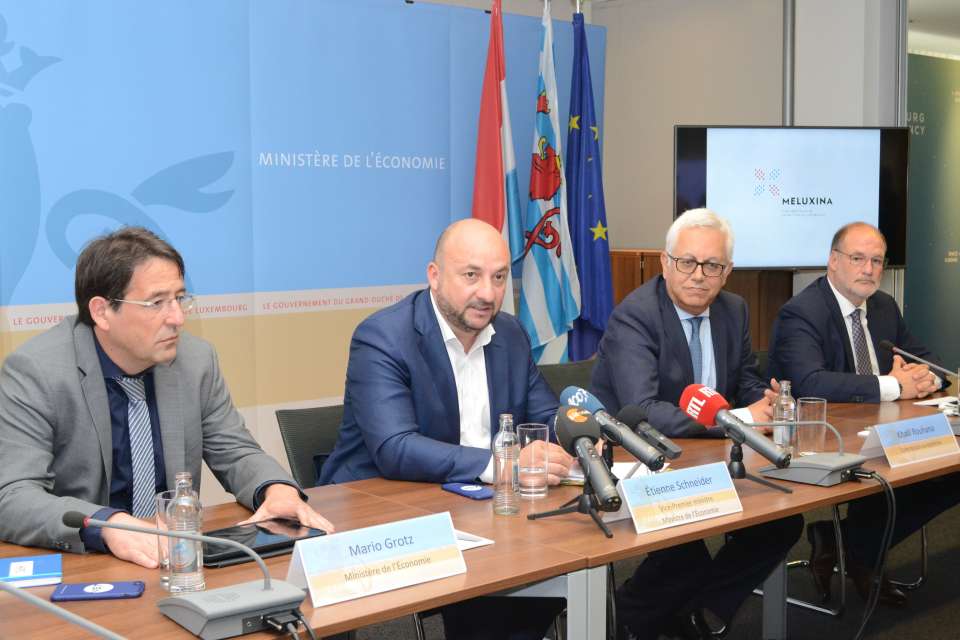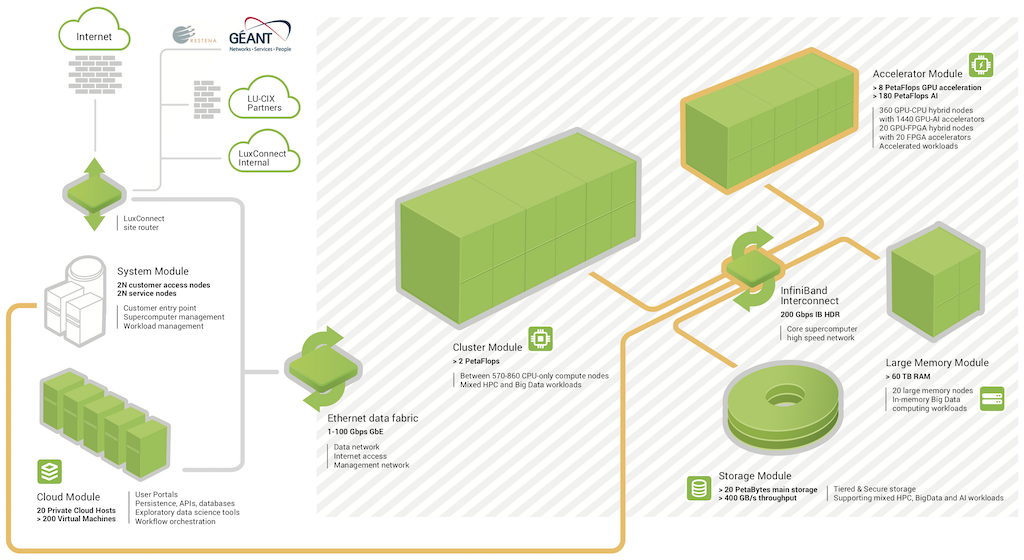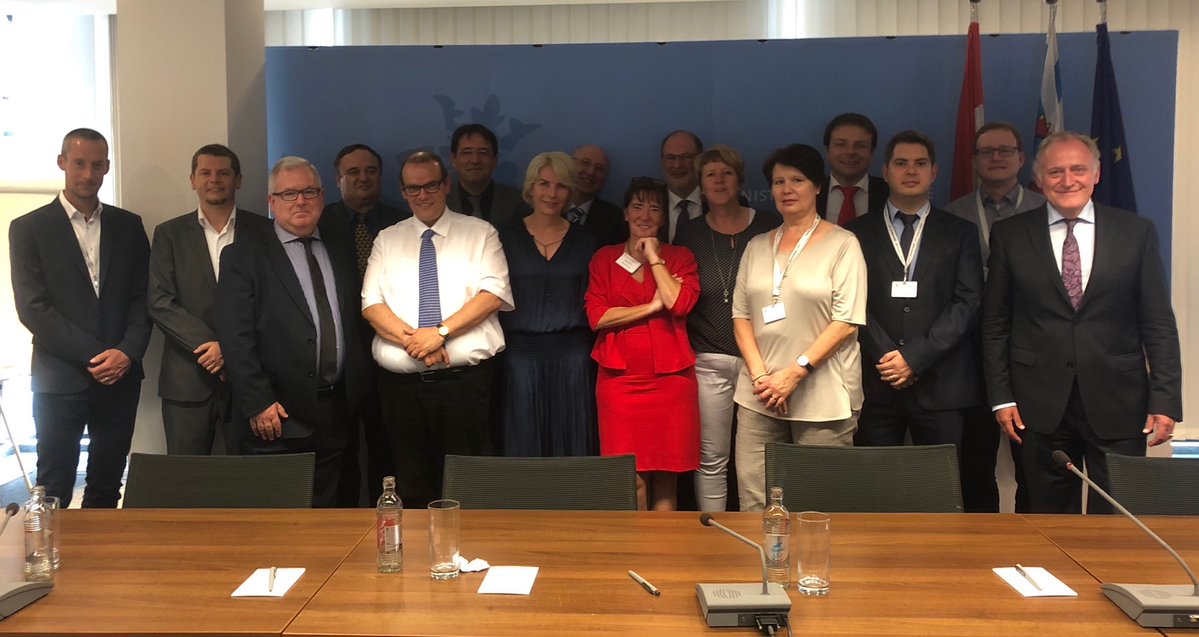The computing and data needs of European scientists and industry do not currently match the computation capabilities available in the EU. For that reason, the EuroHPC Joint Undertaking (JU), headquartered in the Grand Duchy, was created as an initiative co-financed by the European Commission and 28 countries (including Luxembourg), aiming to deploy in Europe a world-class supercomputing infrastructure and a competitive innovation ecosystem in supercomputing technologies, applications and skills.
In February 15th, 2019, an Open Call to select the hosting entities for Petascale supercomputers was released and a consortium was created under the impulsion of the Luxembourg Ministry of Economy to prepare the Luxembourg candidature for this call. Led by LucConnect SA, the consortium involved Luxembourg actors, i.e. the University through its HPC team (in particular Prof. P. Bouvry, Dr. S. Varrette and V. Plugaru) and LIST (in particular Dr. F. Bongiovanni), as well as the reference Jülich Supercomputing Center (JSC) and its historical partner Par-Tec Cluster Competence Center. After tremedous efforts from all partners, the Luxembourg proposal was finalized and submitted to EuroHPC JU by LuxConnect CEO Roger Lampach on April 12th, 2019.
Following a pre-selection of the Luxembourg candidature, an hearing session was organized in Brussels on May 21th, 2019 (where V. Plugaru was delegated to represent the University and LIST). Finally, on June 7th, 2019, EuroHPC selected on total eight sites in different Member States to host supercomputers, including five for petascale systems:
- Pre-exascale systems: Kajaani (Finland), Barcelona (Spain) and Bologna (Italy)
- Petascale systems: Ostrava (Czech Republic), Bissen (Luxembourg), Minho (Portugal), Maribor (Slovenia) and Sofia (Bulgaria).
The Luxembourg project, called Melixina and aiming to install a 10 Pflops supercomputer at LuxConnect in Bissen, was thus selected and will obtain European co-financing (around 35% in CAPEX) for the realization of its own HPC which will integrate the European network of supercomputers.
 On June 14th, 2019, a press conference was organized where the Deputy Prime Minister, Minister of the Economy, Étienne Schneider, the Deputy Director General of the EU DG Communication Networks, Content and Technologies, Khalil Rouhana, as well as LuxConnect CEO Roger Lampach presented the project.
Hosted, operated and marketed by LuxConnect on its site in Bissen, MeluXina will be dedicated to applications in research, personalized medicine and eHealth projects, but also to the needs of companies, in particular SMEs and start-ups. In order to facilitate access to the use of Meluxina’s capabilities, a specific skills center will guide and support companies with limited skills in this area.
The role of the University (and the HPC team) at this level, but also with regards the support in the management and the operation of the system, is still to be defined (typically through a partnership agreement).
On June 14th, 2019, a press conference was organized where the Deputy Prime Minister, Minister of the Economy, Étienne Schneider, the Deputy Director General of the EU DG Communication Networks, Content and Technologies, Khalil Rouhana, as well as LuxConnect CEO Roger Lampach presented the project.
Hosted, operated and marketed by LuxConnect on its site in Bissen, MeluXina will be dedicated to applications in research, personalized medicine and eHealth projects, but also to the needs of companies, in particular SMEs and start-ups. In order to facilitate access to the use of Meluxina’s capabilities, a specific skills center will guide and support companies with limited skills in this area.
The role of the University (and the HPC team) at this level, but also with regards the support in the management and the operation of the system, is still to be defined (typically through a partnership agreement).
As advertised, MeluXina will be powered exclusively by green energy from Kiowatt, a cogeneration power plant fueled by waste wood. The supercomputer will be operational by the end 2020 and will have a computing power of 10 petaflops. An overview of the architecture of the system is depicted below.
Disclaimer: while presented during the press conference, this overview is purely indicative and subjected to changes and adaptation at all levels (numbers, technologies, modules, organization etc.).

As a first step, it is claimed that 20 new jobs will be created as part of the implementation of Meluxina and eventually the HPC Competence Center will have up to 50 employees.
The name MeluXina (expanding a suggestion from V.Plugaru ;)) evokes the legend of Count Sigefroi and Melusine, which refers to the origins of Luxembourg and is visually aligned with the country’s signature: “Luxembourg, let’s make it happen. On the one hand, there is fidelity to the values and origins of the country, and on the other hand, openness to new technologies and support for a digital, reliable and dynamic economy.
 Part of the consortium behind the MeluXina proposal (photo taken after the press conference on June 14, 2019)
Part of the consortium behind the MeluXina proposal (photo taken after the press conference on June 14, 2019)







